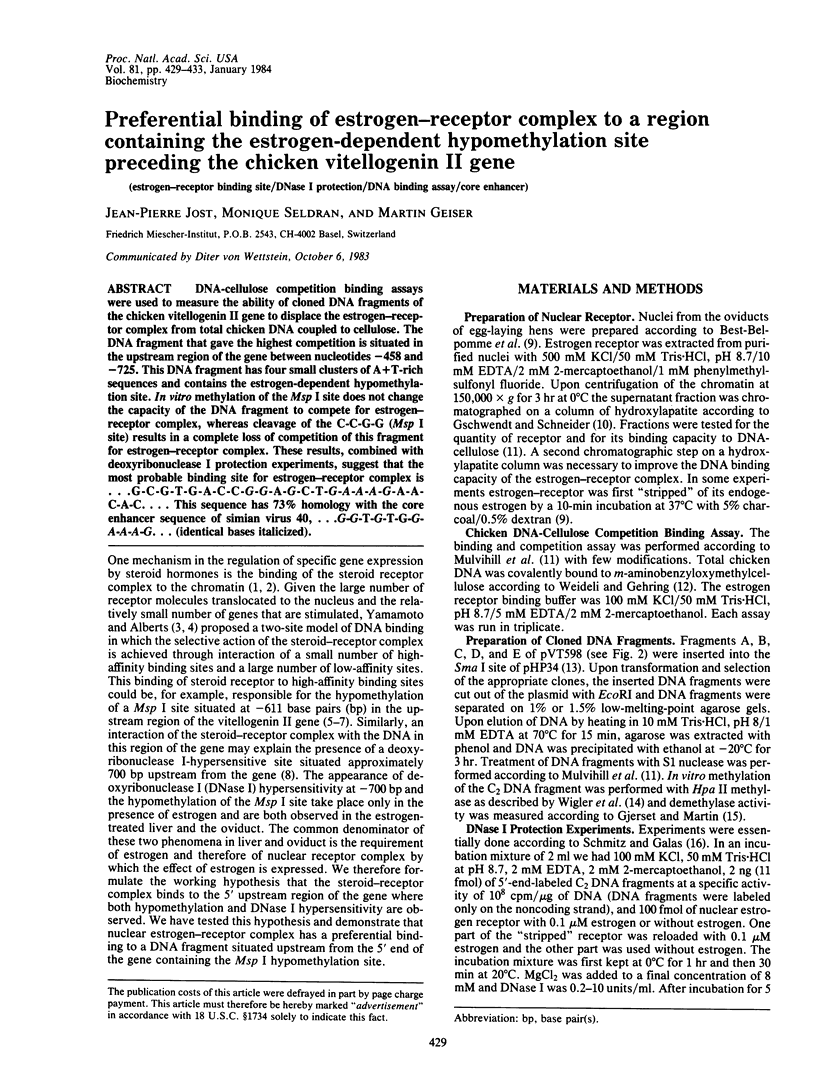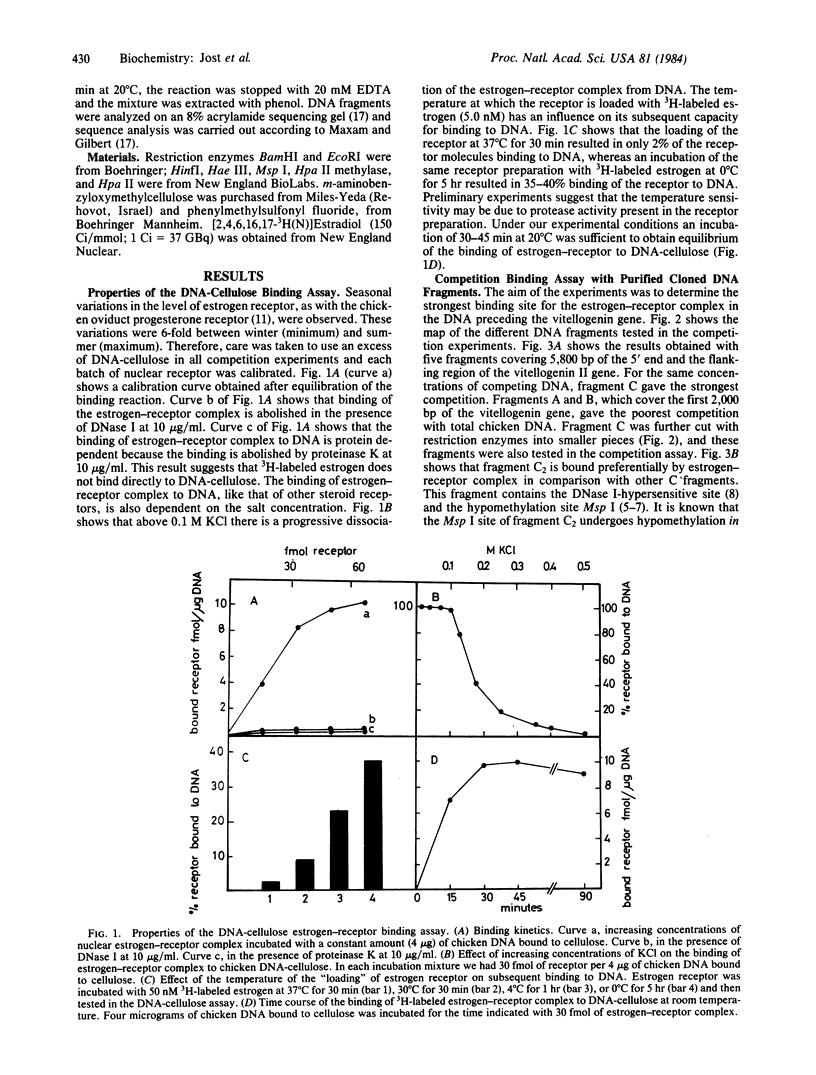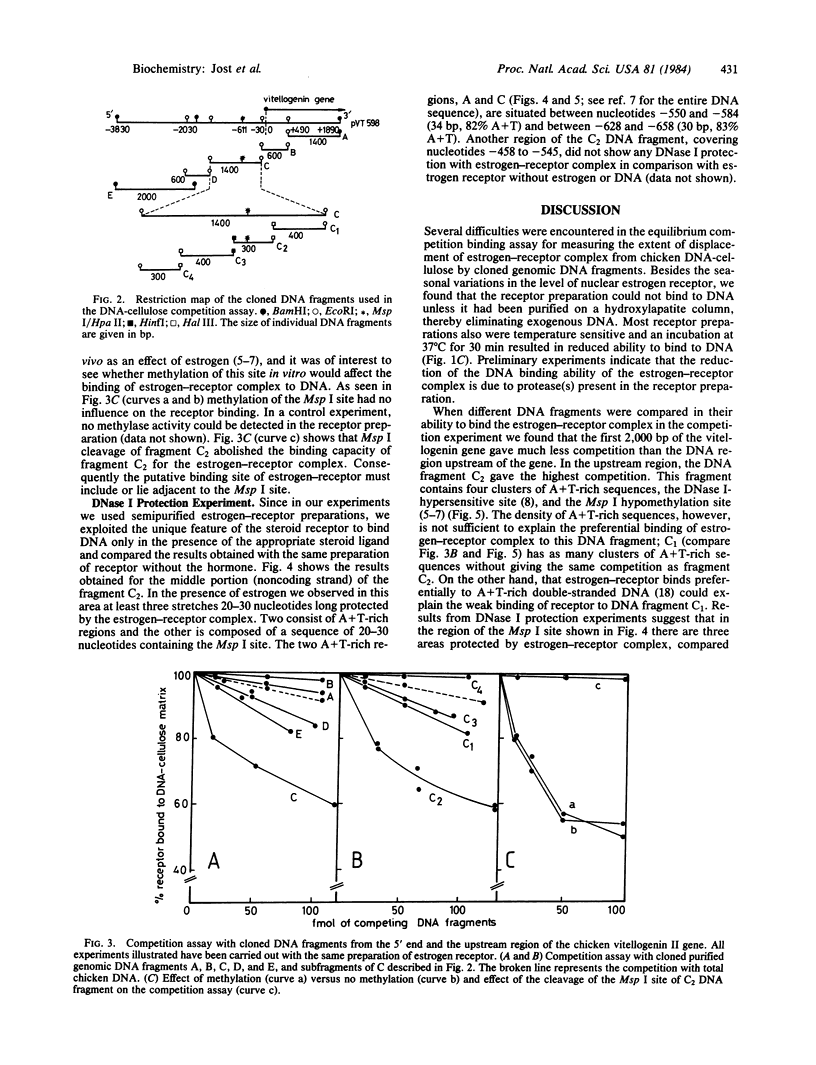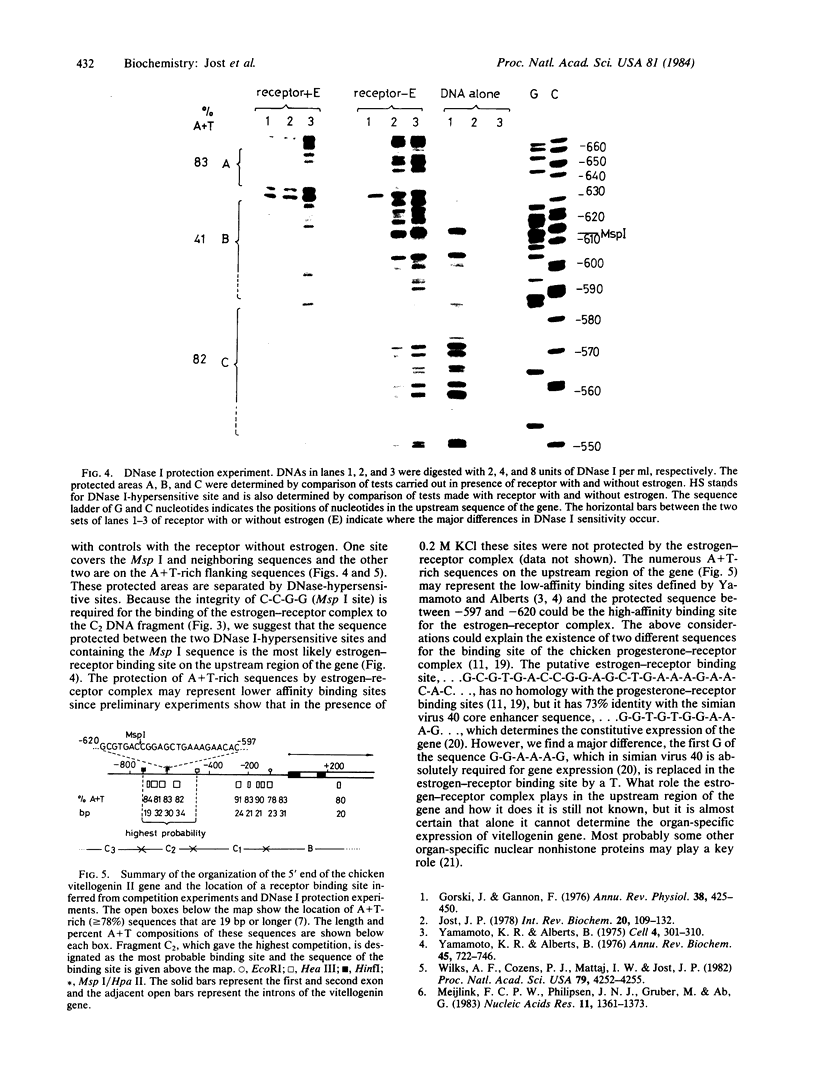Abstract
DNA-cellulose competition binding assays were used to measure the ability of cloned DNA fragments of the chicken vitellogenin II gene to displace the estrogen-receptor complex from total chicken DNA coupled to cellulose. The DNA fragment that gave the highest competition is situated in the upstream region of the gene between nucleotides -458 and -725. This DNA fragment has four small clusters of A + T-rich sequences and contains the estrogen-dependent hypomethylation site. In vitro methylation of the Msp I site does not change the capacity of the DNA fragment to compete for estrogen-receptor complex, whereas cleavage of the C-C-G-G (Msp I site) results in a complete loss of competition of this fragment for estrogen-receptor complex. These results, combined with deoxyribonuclease I protection experiments, suggest that the most probable binding site for estrogen-receptor complex is . . .G-C-G-T-G-A-C-C-G-G-A-G-C-T-G-A-A-A-G-A-A-C-A-C. . . . This sequence has 73% homology with the core enhancer sequence of simian virus 40, . . .G-G-T-G-T-G-G-A-A-A-G. . . (identical bases italicized).
Full text
PDF




Images in this article
Selected References
These references are in PubMed. This may not be the complete list of references from this article.
- Best-Belpomme M., Mester J., Weintraub H., Baulieu E. E. Oestrogen receptors in chick oviduct. Characterization and subcellular distribution. Eur J Biochem. 1975 Sep 15;57(2):537–547. doi: 10.1111/j.1432-1033.1975.tb02329.x. [DOI] [PubMed] [Google Scholar]
- Burch J. B., Weintraub H. Temporal order of chromatin structural changes associated with activation of the major chicken vitellogenin gene. Cell. 1983 May;33(1):65–76. doi: 10.1016/0092-8674(83)90335-5. [DOI] [PubMed] [Google Scholar]
- Compton J. G., Schrader W. T., O'Malley B. W. DNA sequence preference of the progesterone receptor. Proc Natl Acad Sci U S A. 1983 Jan;80(1):16–20. doi: 10.1073/pnas.80.1.16. [DOI] [PMC free article] [PubMed] [Google Scholar]
- Geiser M., Mattaj I. W., Wilks A. F., Seldran M., Jost J. P. Structure and sequence of the promoter area and of a 5' upstream demethylation site of the estrogen-regulated chicken vitellogenin ii gene. J Biol Chem. 1983 Jul 25;258(14):9024–9030. [PubMed] [Google Scholar]
- Gjerset R. A., Martin D. W., Jr Presence of a DNA demethylating activity in the nucleus of murine erythroleukemic cells. J Biol Chem. 1982 Aug 10;257(15):8581–8583. [PubMed] [Google Scholar]
- Gorski J., Gannon F. Current models of steroid hormone action: a critique. Annu Rev Physiol. 1976;38:425–450. doi: 10.1146/annurev.ph.38.030176.002233. [DOI] [PubMed] [Google Scholar]
- Gschwendt M., Schneider W. Estrogen-binding sites of chicken liver. Preliminary characterization of nuclear components. Eur J Biochem. 1978 Nov 2;91(1):139–149. doi: 10.1111/j.1432-1033.1978.tb20946.x. [DOI] [PubMed] [Google Scholar]
- Kallos J., Hollander V. P. Assessment of specificity of oestrogen receptor-DNA interaction by a competitive assay. Nature. 1978 Mar 9;272(5649):177–179. doi: 10.1038/272177a0. [DOI] [PubMed] [Google Scholar]
- Maxam A. M., Gilbert W. Sequencing end-labeled DNA with base-specific chemical cleavages. Methods Enzymol. 1980;65(1):499–560. doi: 10.1016/s0076-6879(80)65059-9. [DOI] [PubMed] [Google Scholar]
- Meijlink F. C., Philipsen J. N., Gruber M., Ab G. Methylation of the chicken vitellogenin gene: influence of estradiol administration. Nucleic Acids Res. 1983 Mar 11;11(5):1361–1373. doi: 10.1093/nar/11.5.1361. [DOI] [PMC free article] [PubMed] [Google Scholar]
- Mulvihill E. R., LePennec J. P., Chambon P. Chicken oviduct progesterone receptor: location of specific regions of high-affinity binding in cloned DNA fragments of hormone-responsive genes. Cell. 1982 Mar;28(3):621–632. doi: 10.1016/0092-8674(82)90217-3. [DOI] [PubMed] [Google Scholar]
- Prentki P., Krisch H. M. A modified pBR322 vector with improved properties for the cloning, recovery, and sequencing of blunt-ended DNA fragments. Gene. 1982 Feb;17(2):189–196. doi: 10.1016/0378-1119(82)90072-5. [DOI] [PubMed] [Google Scholar]
- Schmitz A., Galas D. J. The interaction of RNA polymerase and lac repressor with the lac control region. Nucleic Acids Res. 1979 Jan;6(1):111–137. doi: 10.1093/nar/6.1.111. [DOI] [PMC free article] [PubMed] [Google Scholar]
- Spelsberg T. C., Webster R. A., Pikler G. M. Chromosomal proteins regulate steroid binding to chromatin. Nature. 1976 Jul 1;262(5563):65–67. doi: 10.1038/262065a0. [DOI] [PubMed] [Google Scholar]
- Weideli H., Gehring W. J. A new method for the purification of DNA-binding proteins with sequence specificity. Eur J Biochem. 1980 Feb;104(1):5–11. doi: 10.1111/j.1432-1033.1980.tb04392.x. [DOI] [PubMed] [Google Scholar]
- Weiher H., König M., Gruss P. Multiple point mutations affecting the simian virus 40 enhancer. Science. 1983 Feb 11;219(4585):626–631. doi: 10.1126/science.6297005. [DOI] [PubMed] [Google Scholar]
- Wigler M., Levy D., Perucho M. The somatic replication of DNA methylation. Cell. 1981 Apr;24(1):33–40. doi: 10.1016/0092-8674(81)90498-0. [DOI] [PubMed] [Google Scholar]
- Wilks A. F., Cozens P. J., Mattaj I. W., Jost J. P. Estrogen induces a demethylation at the 5' end region of the chicken vitellogenin gene. Proc Natl Acad Sci U S A. 1982 Jul;79(14):4252–4255. doi: 10.1073/pnas.79.14.4252. [DOI] [PMC free article] [PubMed] [Google Scholar]
- Yamamoto K. R., Alberts B. M. Steroid receptors: elements for modulation of eukaryotic transcription. Annu Rev Biochem. 1976;45:721–746. doi: 10.1146/annurev.bi.45.070176.003445. [DOI] [PubMed] [Google Scholar]
- Yamamoto K., Alberts B. The interaction of estradiol-receptor protein with the genome: an argument for the existence of undetected specific sites. Cell. 1975 Apr;4(4):301–310. doi: 10.1016/0092-8674(75)90150-6. [DOI] [PubMed] [Google Scholar]



